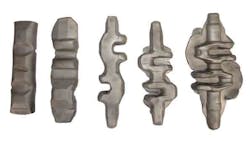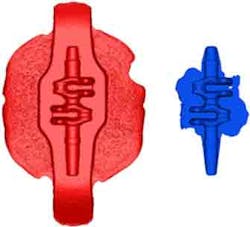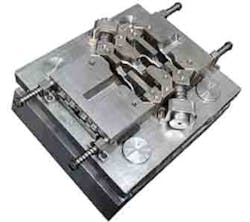A German industrial research center, the Institut für Integrierte Produktion Hannover (IPH) reported it has developed a new forging technique that saves material and energy consumption. In its REForCh research program — "Resource-Efficient Forging Process Chain for Complicated High-Duty Parts" — IPH concluded it can reduce the burr percentage of forged crankshafts from 54% to 7%, saving approximately 20% of energy requirements in the process.
IPH noted industrial-scale tests of the process have been successful, setting the stage for commercial application.
IPH conducted the research over two years with funding from the European Union and participation by forging companies in Spain, Romania, and Turkey. The researchers to significantly reduced the burr percentage in the process of forging a two-cylinder crankshaft. In a conventional forging process for the same product, 10.8 kg of steel were used to forge the 7-kg crankshaft – with a burr percentage of 54 percent.
IPH noted that in standard forging, metal is formed only by the application of force (pressure) from above, so that the surplus material “escapes” to each side. This forms the “burr” that has to be trimmed or ground away in subsequent processing steps. Using multi-directional forging, the heated steel is reformed from above as simultaneous pressure is applied on the sides. So, the crankshaft is formed in a more controlled manner and less material is wasted.
Taking the multi-directional forging approach defined in the IPH process, the burr percentage for the same design decreased to 7%, and required 7.5 kg of steel. The new procedure also saved about 20% in energy requirements because less steel needed to be heated.
IPH has been developing multi-directional forging for more than 10 years, it reported, developing it in the course of several research projects. The REForCh represents the first successful test of the process in an industrial environment.
The REForCh program was conducted for approximately €1.1 million, with participation by six companies and research institutes from Germany, Spain, Romania, and Turkey. The Institut für Elektroprozesstechnik (ETP) of the Leibniz University of Hanover designed the induction heating processes and studied the energy balance of the forging procedure. Aurrenak, a Spanish company, produced the forming tool that can be inserted into a normal eccentric press and diverts the press pressure so that the steel is formed simultaneously from above and the sides.
The successful industrial tests were conducted at Omtaş Otomotiv Transmisyon Aksami in Turkey, where prototypes were produced for two-cylinder crankshafts for quads and snow mobiles, using the multi-directional tool. Now, the aim is to apply the same approach to producing other crankshaft types, which the research institute indicated would be only step short of wider commercial application.
Noting that the research results would benefit all forging companies that seek to conserve materials and energy, IPH offered to share its findings with and advise companies interested in adopting multi-directional forging.


